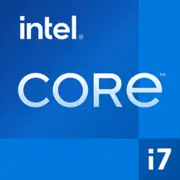Intel Core i7-6700

Intel Core i7-6700: Architecture, Compatibility, and Practical Use in 2025
Updated: April 2025
Key Features: Why Skylake Remained Relevant?
The Intel Core i7-6700 processor, released in 2015, is still present in budget builds and upgrade systems. Its Skylake architecture (14 nm) served as a transitional bridge between outdated 22 nm and more modern generations.
Key Specifications:
- 4 cores / 8 threads thanks to Hyper-Threading.
- Base frequency: 3.4 GHz, Turbo Boost up to 4.0 GHz.
- TDP 65 W: low power consumption for desktop CPUs.
- Integrated graphics HD Graphics 530: supports 4K via HDMI 1.4 and DisplayPort 1.2.
- Geekbench 6: 1285 (Single-Core) / 4117 (Multi-Core).
Architecture Highlights:
- Supports DDR4 and DDR3L (a rarity for 2015).
- Improved energy efficiency over Haswell.
- Enhanced virtualization capabilities (VT-x, VT-d).
Compatible Motherboards: How to Choose Wisely?
The processor uses the LGA 1151 (version 1) socket, but it's important not to confuse it with LGA 1151-v2 (for Coffee Lake).
Compatible Chipsets:
- H110, B150, H170, Z170 (100 series).
- B250, H270, Z270 (200 series).
Recommendations:
- For basic tasks: motherboards based on H110 or B150 (e.g., ASUS H110M-K, ~$60).
- For overclocking (through BCLK): Z170/Z270 (e.g., MSI Z170A Gaming M5, ~$130 on leftovers).
- Attention! 300 series chipsets (Z390 etc.) are incompatible due to pin configuration changes.
Memory: DDR4 vs DDR3L — What to Choose?
The Core i7-6700 supports DDR4-2133 and DDR3L-1600.
Practical Considerations:
- DDR4 is preferred: higher bandwidth and energy efficiency.
- DDR3L operates at reduced voltage (1.35V), but is not compatible with all motherboards (check specifications!).
- Maximum capacity: 64 GB (4 slots × 16 GB).
Practical Example:
Installing 32 GB DDR4-2400 (e.g., Kingston HyperX Fury) is possible, but the frequency will be reduced to 2133 MHz due to controller limitations.
Power Supply: How Many Watts are Enough?
With a TDP of 65 W and no discrete graphics card, a PSU in the 300–400 W range will suffice.
Recommendations for Different Scenarios:
- Integrated graphics: 400 W (e.g., be quiet! System Power 10, ~$55).
- Mid-range graphics card (NVIDIA GTX 1660): 500 W (Corsair CX550, ~$70).
- Certification: 80 Plus Bronze or higher for stability.
Pros and Cons: Is It Worth Buying in 2025?
Advantages:
- Price: $150–200 (new units from distributors).
- Energy efficiency: suitable for mini-PCs and office builds.
- Reliability: proven architecture with a low failure rate.
Disadvantages:
- No support for PCIe 4.0/5.0: a limitation for modern SSDs and graphics cards.
- Weak upgrade path: transitioning to new generations requires replacing the motherboard and RAM.
- Outdated graphics: HD 530 won't handle 2025 games even on low settings.
Use Cases: Where Does i7-6700 Still Shine?
1. Office Tasks:
- Document work, browsing, video chats.
- Example: a build based on i7-6700 + 16 GB DDR4 + 500 GB SSD runs smoothly even in 2025.
2. Multimedia:
- Streaming video (Netflix 4K), editing in Adobe Premiere (FullHD projects).
3. Gaming:
- CS2, Dota 2, GTA V on medium settings with a discrete graphics card (GTX 1060 or equivalents).
- For Cyberpunk 2077 or Starfield, the CPU becomes a bottleneck.
4. Home Server:
- Virtualization (Proxmox, ESXi) thanks to VT-d support.
Comparison with Competitors: AMD vs Intel
AMD Ryzen 5 1600 (2017):
- 6 cores / 12 threads, but lower IPC (Geekbench 6 Multi-Core ~3800).
- Price: ~$180 (new units).
- Pros: more cores for multi-threaded tasks.
- Cons: requires an AM4 motherboard.
Intel Core i5-10400 (2020):
- 6 cores / 12 threads, Geekbench 6 Multi-Core ~5500.
- Price: ~$220.
- Conclusion: i7-6700 lags in multi-threading but is cheaper.
Building Tips: How to Avoid Mistakes
1. Check BIOS: 100 series motherboards may require an update to work with the i7-6700.
2. Choose NVMe SSDs: Even PCIe 3.0 x4 (via an adapter) will speed up the system.
3. Cooling: The stock cooler is sufficient, but for quieter operation, consider a DeepCool Gammaxx 400 (~$25).
4. Don't skimp on memory: 16 GB DDR4 is the minimum for multitasking.
Conclusion: Who Is This Processor For?
The Core i7-6700 is suitable for:
- Budget users: Building a PC under $500 with a focus on reliability.
- Owners of older systems: Upgrading from a Core i5-4460 without replacing the motherboard.
- DIY enthusiasts: Creating a compact media center or NAS.
Why you might not want it:
If you need support for modern games or AI tools, it's better to choose a Ryzen 5 7600 or Core i5-13400.
Final Thoughts
The Intel Core i7-6700 in 2025 is a niche solution. It lags behind newer CPUs in performance but remains a viable option for the secondary market and specific use cases. The key is to clearly assess your needs and component compatibility.
Basic
CPU Specifications
Memory Specifications
GPU Specifications
Miscellaneous
Benchmarks
Compared to Other CPU
Share in social media
Or Link To Us
<a href="https://cputronic.com/cpu/intel-core-i7-6700" target="_blank">Intel Core i7-6700</a>